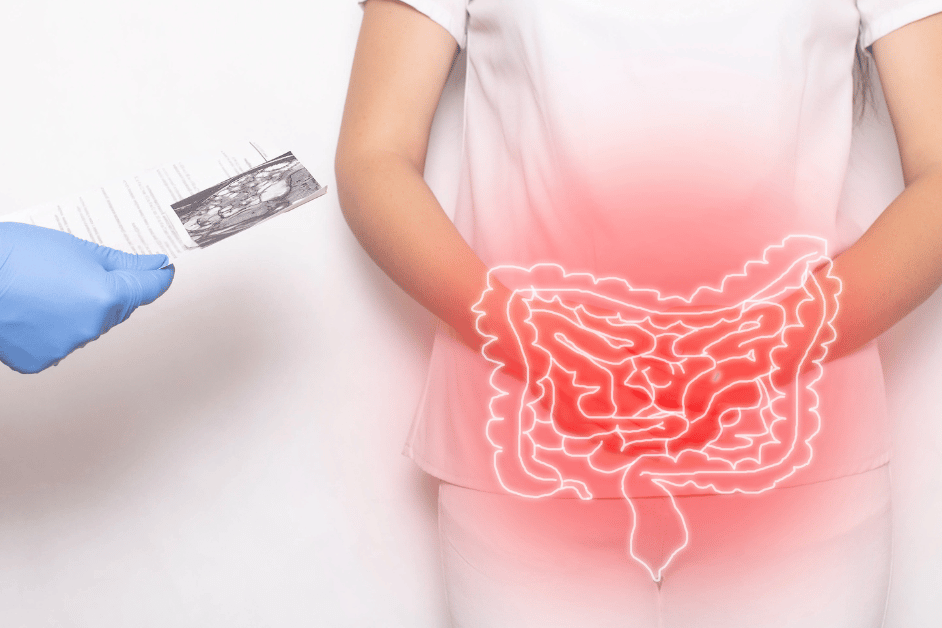Everything is connected.
It’s one of my key beliefs in medicine, and when it comes to your gut health and thyroid problems, it holds true.
If you’re struggling with thyroid symptoms OR gut issues, I want to take a look at both… because where we find one, we often find the other! And if you only try to fix one issue, you’ll wind up spinning your wheels, unable to fully heal.
And if you’re facing a thyroid issue, this is ESPECIALLY true.
Today, I want to explain exactly how gut infections and thyroid health are linked – and what you can do to find and address gut infections to achieve better thyroid health.
You – Yes, YOU – Could Have A Gut Infection
No one wants to think they could have any sort of gut infection or parasite. First of all, there is the “ick” factor associated with parasites and infections. Just talking about it might make your skin crawl!
Plus, most people think that gut infections only happen if they are drinking “dirty” water or travelling to far-flung countries.
But that just isn’t true! Even in North America, Europe, and Australia, gut infections happen all the time! Even very clean and careful people can become infected when doing everyday activities – like swimming, gardening, or eating out. If you have pets, kids, like to hike or spend any time outdoors, and eat or drink ANYTHING… you’re at risk of a gut infection.
So don’t panic… we’re exposed to potential pathogens all the time! You can likely think of one you know you’ve had… food poisoning.
Plus, one of the most common infections is actually overgrowth of commensal bacteria or fungi – which just means bacteria that belongs in the gut naturally either overgrows or grows where it doesn’t belong.
That’s why I bring up the topic of gut infections and parasites with all my patients.
Gut Red Flags To Beware Of
If you come to see me as a patient, I look for these warning signs that could indicate some sort of gut infection could be a factor:
- Diarrhea
- Constipation
- Abdominal pain
- Vomiting
- Gas and bloating
- Ulcers
- Weak immune system
- Autoimmunity
- Extreme fatigue
- Nutritional deficiencies
- Brain fog
- Sugar cravings
- Depression
- Anxiety
- Joint pain
- Obesity
- Food intolerances – especially developing new sensitivities
- Skin conditions – such as psoriasis, rosacea, and eczema
Or, any of these conditions, either diagnosed or suspected:
- Intestinal Permeability (leaky gut)
- Chronic and Acute Gastroenteritis
- Inflammatory Bowel Disease (IBD – Crohn’s or ulcerative colitis)
- Irritable Bowel Syndrome (IBS)
- Autoimmune Disease
- Small Intestine Bacterial Overgrowth (SIBO)
And of course, anyone with any type of hormonal issues – but especially thyroid or sex hormones – gets a closer look, since gut infections and hormones are so closely linked.
These Are The Tests I Order…
Have some red flags? It’s time to test!
First up are stool tests. This is where I start for almost all patients.
My personal favorite stool test is the GI Map.
Why do I like it? Compared to a regular stool test, the GI Map uses qPCR (quantitative) Technology, which is a more accurate way to detect and quantify organisms compared to more common culture, regular PCR, microscopy or DNA sequencing. qPCR works by amplifying and detecting DNA and RNA sequences, which is key because for results to be clinically meaningful, you need to know how much DNA is in the stool.
The GI Map test is also reproducible, which means that if you run it twice in a row, you get the same results – this is a key quality to look for in any diagnostic test. It’s used in research settings and it is the first pathogen assay that is FDA approved.
Other tests I like and sometimes use are:
- BiomeFx – this is a newer test that uses Whole Genome Sequencing to analyze over 25 pathogens measures their relative abundance as a percentage of your entire microbiome. This is different from traditional stool tests, which only look for any detectable number of pathogens present. While it isn’t uncommon to have a small number of pathogens present in your microbiome, the relative abundance in proportion to your other bacteria is what’s important.
- GI360 by Doctors Data
If you have constipation, diarrhea, gas, significant bloating or a history of food poisoning, I’ll also ask for a SIBO Breath Test.
If you have candida overgrowth symptoms like a history of antibiotic use, yeast infections, urinary tract infections or interstitial cystitis, chronic itching in groin, fungal toe nails, you’re reactive to yeast in foods, have been diagnosed with methane SIBO, have sugar or carb cravings, or stubborn weight issues, but the stool test doesn’t show candida, I will order Organic Acids, and/or Serum Antibodies to further suggest candida overgrowth treatment would be beneficial for you.
What Your Gut Test Results Can Reveal
Once I’ve got your test results back, the real fun can begin: interpretation and treatment!
But I don’t just glance at your results: I comb through all the details, connecting dots to put together a comprehensive picture of what’s happening with your health.
Here’s a peek at what I’m looking for in your test results:
Inflammation/Immune Markers
-
- Calprotectin – this is key for differentiating between Inflammatory Bowel Disease (IBD) and Irritable Bowel Syndrome (IBS) (some tests also have lactoferrin). If below 120, it suggests infection, chronic NSAID use, or could be polyps, colorectal cancer or IBD. If above 120, it’s a sign of significant inflammation–which may be caused by an infection, but also generally receives a recommendation for referral to a GI doc if you’re working with me, as it can be suggestive of Celiac, or Inflammatory Bowel Disease such as Chrons’ or Ulcerative Colitis. (Gastroenterologists may suggest colonoscopy to rule these out when calprotectin levels cross a particular threshold). Each lab has a different range and sensitivity for calprotectin, so practitioners should use that lab’s range. Should be rechecked at 4-6 weeks or after treatment.
-
- Zonulin – this is a keymarker of leaky gut.
-
- SIgA – this is a marker of gut secretory immunity and barrier function and can show loss of resilience and tolerance. I look at this for signs of chronic infection, immune suppression, and/or adrenal hormone dysfunction.
Digestion and Absorption
-
- Pancreatic Elastase-1 – this marker reflects levels of pancreatic digestive enzymes present. There are many reasons why someone might have sub-optimal digestive enzymes, but regardless of the cause, we will want to supplement with enzymes at least in the short term.
-
- Fecal Fat – this is a marker of fat breakdown and absorption. If really low, it’s a sign a patient is not eating enough fat (<5%). If high, it indicates fat malabsorption/digestion. I’ll want to consider bile flow/production issues, enzyme deficiency, or SIBO.
-
- Short-Chain Fatty Acids and Beta-Glucuronidase – these are functions of the bacteria in the microbiome that reflects if good bacteria are present in adequate numbers or if less desirable bacteria are overpopulated. SCFA are the main fuel for cellular repair of the barrier membrane. High beta-glucuronidase can be a cause of estrogen dominance, and can also signal overall issues with not just the gut, but liver detox, depending on the level.
Microbiome
-
- Commensal bacteria – these are your “good bacteria” – and this also shows which bacteria are in low number, and which are missing altogether
-
- Parasitology – looking for infections like campylobacter, giardia, Blastocystis hominis, entamoeba histolytica, etc are present.
-
- Mycology – this clues me in to what fungi and yeast are present.
-
- Pathogenic bacteria – aka bad bacteria, or bacteria that can be either bad or good (like H Pylori)
-
- Worms – Yes it is gross, but it’s not the end of the world!
What Does All This Have to Do with Your Thyroid?
Let’s bring this all back around to your main concern: your thyroid!
Research has actually linked multiple gut infections to thyroid issues. Here’s a breakdown of some of the most common ones:
Blastocystis hominis
This common gut infection (often called Blasto for short), which is spread via contaminated food or stool, can cause symptoms including bloating, diarrhea, nausea, flatulence, variable bowel habits, abdominal pain, hives, and fatigue. Additionally, this pathogen is notorious for causing multiple food sensitivities.
It’s also linked to Hashimotot’s thyroiditis: people with Hashimoto’s are more likely to develop the skin condition chronic spontaneous urticaria (also known as chronic hives), as well as irritable bowel syndrome (IBS). And a study of 54 people in Egypt with chronic urticaria (hives) revealed that Blastocystis hominis was found in 61 percent of them, while only eight percent of the healthy controls had the parasite, suggesting that Blasto could be linked to hives, IBS, and Hashimoto’s.
Epstein-Barr Virus
Epstein-Barr Virus is a common virus best known for causing the disease mononucleosis.
Research out of Poland supports my informed hunch that it’s also linked to Hashimoto’s. A 2015 study done there found the virus in the thyroid cells of 80 percent of people with Hashimoto’s, while controls did not have the Epstein-Barr virus in their thyroid gland.
Yersinia Enterocolitica
This infection is often caused by consuming undercooked meat or drinking contaminated water. There is some evidence that Y. enterocolitica is associated with autoimmune thyroid disorders including Graves’s disease and Hashimoto’s thyroiditis in genetically susceptible individuals because higher antibodies to Y. enterocolitica are often found in these patients.
Helicobacter Pylori
This ultra-common infection/overgrowth, best known as a cause of ulcers, is also linked to autoimmune thyroid disorders. In a Korean study, those who were positive for H. pylori were significantly more likely to also have anti-thyroid peroxidase antibodies present.
Small Intestine Bacterial or Fungal Overgrowth (SIBO or SIFO)
Both bacterial and fungal overgrowth in the small intestine is linked to hypothyroidism – research has shown as much as 54% of people with hypothyroidism also have SIBO or SIFO.
These overgrowths can also deplete iron, which is involved in thyroid hormone synthesis.
In my own clinical experience, many of those with Hashimoto’s often have a high degree of yeast overgrowth and symptoms to go with it: gas, bloating, brain fog, sinus congestion, GI distress, itchy skin or scalp, eczema, vaginal yeast infections, and intestinal permeability.
Giardia
Giardia is another common parasite most commonly caused by drinking contaminated water. Some research has shown it can prevent the absorption of thyroid hormones in the gut, leading to hypothyroidism. (While I don’t have studies to support it– just my own observation with my clients– I suspect this could be true for any parasite or overgrowth causing inflammation in the gut, and not just Giardia.) But the good news is clearing the infection reverses hypothyroidism!
Connecting the Dots & Creating Your Treatment
With the right testing, you might finally be able to “see” what caused your thyroid issues – or is exacerbating them: a gut infection.
All the testing and interpretation brings us to the most exciting point: treating your gut issues, And with that information in hand, we can co-create a 100% unique treatment plan for you.
For my clients, I always create a custom protocol based not only on their test results, but also with their budget and lifestyle in mind. I don’t believe in a one-size-fits-all approach to medicine, which means if you have a strict supplement budget to stick with, or really, really, REALLY don’t want to give up a particular food, we try our best to find a way to work with it so that you get the results you want, within your parameters.
If you want to learn more about what it’s like to work with me as a practitioner, sign up for a no-obligation 15-minute Intro Session here.
This is your chance to share your story with my team and get a realistic look at what working with us is like.
>>> Book an Intro Session Here
I hope this information was helpful to you – and you can find tons more over at my blog: https://briewieselman.com/
- Brie Wieseleman, L.Ac
At the Reverse-Age Method, we believe in a holistic approach to perimenopause and beyond, that addresses the root causes of your symptoms (like insomnia, hot flashes, night sweats, erratic periods, fatigue, skin aging, weight gain, and brain fog)– to also slow the pace that your cells are aging. Whether it’s improving gut health, optimizing detox function, enhancing mitochondrial function, or building muscle mass, our comprehensive program has got you covered.
If you’re new here, be sure to check out our Blog Page for more insights and tips on how to thrive during perimenopause. Our blog is packed with practical advice, success stories, and the latest research to help you on your journey.
For more updates and community support, follow us on social media:
You May Also Like...
Fiber and Veggie Muffins
Here’s one of my favorite recipes for muffins - kids love it, and it packs a great dose of fiber and veggies.…
How to Heal Ulcerative Colitis: A Case Study
If you have ulcerative colitis, this is a case study you’re going to want to read. It’s about a woman—I’ll call her…
Whether you’re looking for help with your gut, your hormones, or both, our team of practitioners work together to treat the WHOLE you – guiding you to a healthier mind, body, and spirit day by day.



